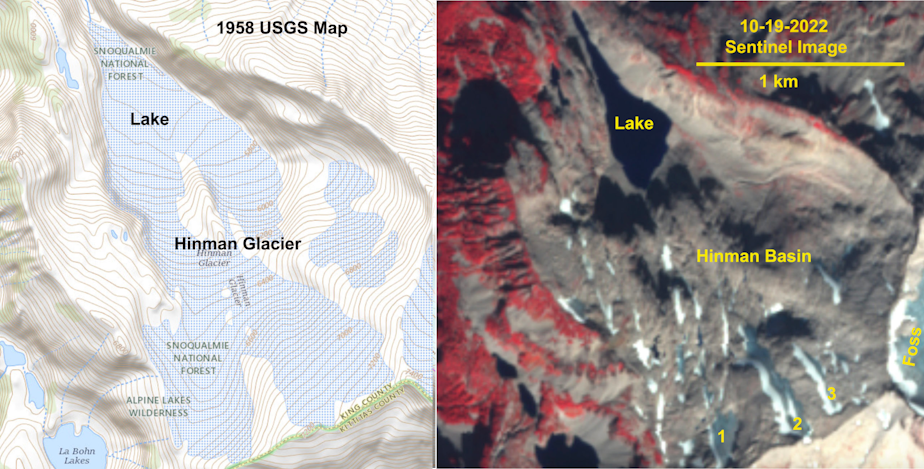RIP Washington’s Hinman Glacier, gone after thousands of years

The largest glacier between the high peaks of Mount Rainier and Glacier Peak has melted away after a long battle with global warming.
For thousands of years, the Hinman Glacier graced the crest of the Washington Cascades in what is now King County.
Fifty miles due east of downtown Seattle, Mount Hinman sits deep in the Alpine Lakes Wilderness, midway between Snoqualmie Pass and Stevens Pass.
Nichols College glaciologist Mauri Pelto led a team to Mount Hinman in August 2022, as he has most summers since 1984. This time, they found its namesake glacier was no more.
In its place were just a few stranded patches of snow and ice.
“This is the biggest North Cascade glacier to completely disappear,” Pelto said. “I've seen a bunch of small glaciers disappear, and to see one of the larger glaciers disappear is more striking.”
Until recently, the Hinman was one of four named glaciers that provided cool water to the Skykomish River in the hottest, driest time of the year.
The glaciers of the Skykomish basin have lost 55% of their surface area since the 1950s, according to Pelto.
“What that means is, you have 55% less of an ice cube there to melt all summer long,” Pelto said.

As the Hinman dwindled to almost nothing in recent decades, late-summer flows got lower in the Skykomish River, bad news for salmon and farmers.
The Hinman Glacier was ancient, though how ancient is unknown. It might date from the retreat of the Cordilleran ice sheet, which left glaciers atop the Cascades and Olympics 14,000 years ago. Pelto said there is strong evidence that the Hinman was older than the explosion of Mount Mazama, which created Oregon’s Crater Lake, 7,000 years ago.
In the 1950s, the Hinman Glacier flowed a mile and a half from the broad top of 7,492-foot Mount Hinman to the valley floor nearly 2,000 feet below.
Mount Hinman and its neighbors gained protection from direct human disturbance in 1976 when they were designated part of the Alpine Lakes Wilderness. But that designation couldn’t protect Hinman’s snow and ice from a warming climate: They were no match for the rising temperatures of the fossil fuel era.
“Once the largest glacier between Mount Rainier and Glacier Peak,” mountain climber and guidebook author Fred Beckey wrote in the 2000 edition of his Cascade Alpine Guide, “the Hinman Glacier has separated into three masses, with a greatly diminished area.”
In 1958, the Hinman Glacier covered 320 acres, about half the size of Seattle’s Lake Union. In August 2022, the biggest patch of ice Pelto’s team found was about 10 acres—too small and too thin to flow, the defining characteristic of the moving ice masses called glaciers.
Glaciers are rivers of ice. They flow from year to year, as their own weight compresses snow into ice, and generate striking features like deep crevasses and deep-blue ice, sculpting the land beneath them as they go.
Another glacier on Mount Hinman, the Lower Foss, preceded the Hinman into oblivion, while one other, the Foss, remains, though it has shrunken by 70% since the 1950s.
The rounded peak and the glacier on its northwest side were named for Everett dentist and mountain climber Harry B. Hinman in 1934. He started the Everett branch of the Mountaineers in 1911.
Few people ever touched the Hinman Glacier, reachable only by off-trail scrambling and mountaineering deep inside the rugged Alpine Lakes Wilderness.
But the Hinman touched many people by keeping the Skykomish River cool and flowing each summer and providing water for fish and farmers when they needed it most.
RIP (rest in precipitation), Hinman Glacier.

Correction, 2:00 p.m., 2/23/2023: An earlier photo caption did not credit photographer Tom Davenport.
